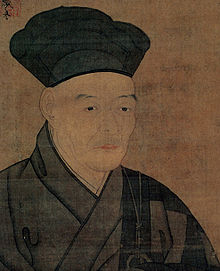Sesshu Toyo
| Sesshū Tōyō | |
|---|---|

A 16th-century copy of Sesshū's 1491 self-portrait
|
|
| School | Rinzai |
| Personal | |
| Born | 1420 Bitchū, Japan |
| Died | 26 August 1506 |
| Senior posting | |
| Title |
|
| Religious career | |
| Teacher | Tenshō Shūbun |
Sesshū Tōyō (Japanese: 雪舟 等楊; Oda Tōyō since 1431, also known as Tōyō, Unkoku, or Bikeisai;1420 – 26 August 1506) was the most prominent Japanese master of ink and wash painting from the middle Muromachi period. He was born into the samurai Oda family (小田家), then brought up and educated to become a Rinzai Zen Buddhist priest. However, early in life he displayed a talent for visual arts, and eventually became one of the greatest Japanese artists of his time, widely revered throughout Japan and China.
Sesshū studied under Tenshō Shūbun and was influenced by Chinese Song dynasty landscape painting. In 1468–69, he undertook a voyage to Ming China, where too he was quickly recognized as an outstanding painter. Upon returning to Japan, Sesshū built himself a studio and established a large following, painters that are now referred to as the Unkoku-rin school—or "School of Sesshū". Although many paintings survive that bear Sesshū's signature or seal, only a few can be securely attributed to him. His most well-known work is the so-called "Long Landscape Scroll" (山水長巻, Sansui chōkan).
Sesshū was born in Akahama, a settlement in Bitchū Province, which is now part of western Okayama Prefecture. His family name was Oda, but his original name is unknown. He received the name Tōyō in 1431, when he was enrolled at the Hōfuku-ji, a Zen temple in Sōja. Kanō Einō's History of Japanese Painting (Honchogashi), a 17th-century source, contains a well-known anecdote about the young Sesshū: apparently the future painter did not study Zen with enough dedication, preferring instead to spend his time drawing. Once, he was punished for disobedience and tied to a pillar in the hall of the temple. After a while, a priest came to see him and jumped up with surprise—there was a mouse very close to Sesshū's foot. However, it was actually a picture which Sesshū had painted with his tears. Although the story is famous, its authenticity is questionable. At any rate, during his early studies Sesshū would have received instruction not only in religion, but also calligraphy and painting.
...
Wikipedia
